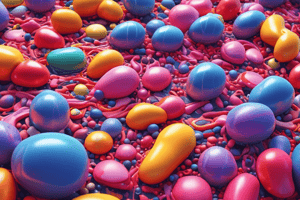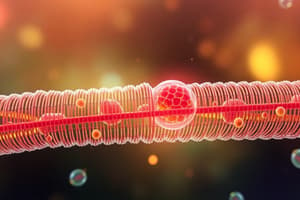Podcast
Questions and Answers
What is the plasma membrane of the cell composed of?
What is the plasma membrane of the cell composed of?
The plasma membrane is composed of two layers of phospholipids and cholesterol.
What are protein molecules?
What are protein molecules?
Proteins on the membranes serve as receptors and help transport substances.
Where are cholesterol molecules found?
Where are cholesterol molecules found?
Cholesterol is found in the plasma membrane.
What are lysosomes?
What are lysosomes?
What is the Golgi apparatus?
What is the Golgi apparatus?
What are centrioles?
What are centrioles?
What is a nucleolus?
What is a nucleolus?
What is cilia?
What is cilia?
What does the nucleolus do?
What does the nucleolus do?
What is flagellum?
What is flagellum?
What is phagocytosis?
What is phagocytosis?
What happens when a blood cell is placed in an isotonic solution?
What happens when a blood cell is placed in an isotonic solution?
What is hypertonic?
What is hypertonic?
What is the difference between active and passive transport?
What is the difference between active and passive transport?
How does DNA differ from RNA?
How does DNA differ from RNA?
What is the largest cell in the body?
What is the largest cell in the body?
Where is the cytoplasm and interstitial fluid found?
Where is the cytoplasm and interstitial fluid found?
What makes up the cytoskeleton?
What makes up the cytoskeleton?
What are microvilli?
What are microvilli?
What happens during transcription?
What happens during transcription?
What is the function of transfer RNA?
What is the function of transfer RNA?
Flashcards are hidden until you start studying
Study Notes
Plasma Membrane
- Composed of a bilayer of phospholipids, providing a fluid framework.
- Cholesterol molecules stabilize the membrane to prevent breakage.
Protein Molecules
- Function as transporter channels and carriers for selective substance movement through the plasma membrane.
- Some proteins serve as receptors for other molecules.
Lysosomes
- Membranous organelles that contain enzymes for hydrolysis.
- Digest nutrients and destroy invading microbes, acting as protective "digestive bags."
Golgi Apparatus
- Consists of flattened stacks that process, package, and deliver proteins and lipids from the endoplasmic reticulum (ER).
- Vesicles transport newly formed proteins for further processing and packaging.
Centrioles
- Paired organelles found in the centrosome, essential for cell division.
- Composed of microtubules, aiding in the formation of spindle fibers.
Nucleus and Nucleolus
- The nucleus houses most genetic information and controls cellular activities, including reproduction.
- The nucleolus is a dense region critical for ribosome formation.
Cilia and Flagella
- Cilia are fine, hair-like extensions that help cells sense their environment and can move.
- Flagella are longer projections that propel cells; the only human example is found in sperm.
Active and Passive Transport
- Active transport requires energy (ATP) for substance movement against concentration gradients; passive transport does not.
- Processes include diffusion, osmosis, filtration, and dialysis.
Mitosis Stages (IPMAT)
- Interphase: DNA replication, cell growth.
- Prophase: Chromatin condenses, spindle fibers form.
- Metaphase: Chromosomes align at the cell's center.
- Anaphase: Chromosomes are pulled away from the center.
- Telophase: Nuclear envelope forms, cytoplasm divides.
Cell Membrane Functions
- Separates cell contents from interstitial fluid, maintaining internal environment.
Ribosomes
- Composed of ribosomal RNA (rRNA) and proteins, essential for protein synthesis.
Endoplasmic Reticulum (ER)
- A network of membranes; Rough ER synthesizes proteins, while Smooth ER produces membranes and other substances.
Mitochondria
- Composed of two membranes, involved in energy production through cellular respiration, creating ATP.
Differences Between DNA and RNA
- DNA lacks ribose and is double-stranded; RNA contains ribose and uracil instead of thymine.
Cytoplasm vs. Interstitial Fluid
- Cytoplasm is the fluid within the cell; interstitial fluid surrounds cells, providing nutritional support.
Cytoskeleton Composition
- Composed of microfilaments and microtubules that provide structural support and facilitate movement.
Microvilli
- Small projections that increase surface area for absorption.
Transcription and Translation
- Transcription: DNA unwinds and mRNA is synthesized as a copy of the gene.
- Translation: Ribosomes read mRNA codons to synthesize proteins via tRNA.
Functions of Transfer RNA (tRNA)
- Acts as an adapter during protein synthesis by bringing specific amino acids to the mRNA.
Organelles Containing Nucleic Acids
- Nucleus (DNA), Ribosomes (rRNA), Mitochondria (circular DNA), Chloroplasts (similar to mitochondria).
Isotonic Solutions
- Solutions with equal concentration of solutes as inside cells, causing no net water movement and maintaining cell shape.
Hypertonic Solutions
- Solutions with higher concentrations, causing cells to lose water and shrink (crenation).
Largest and Smallest Human Cells
- The ovum is the largest at 150 micrometers; red blood cells are the smallest at 7.5 micrometers.
Ion Pumps
- Specialized proteins that actively transport ions across membranes using ATP, specific to particular ions like sodium and potassium.
Studying That Suits You
Use AI to generate personalized quizzes and flashcards to suit your learning preferences.




